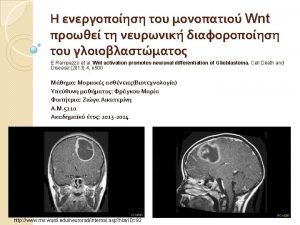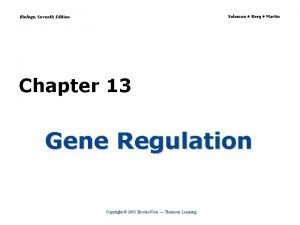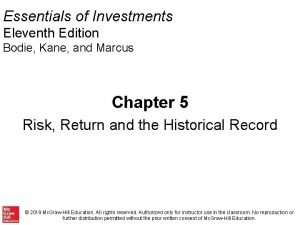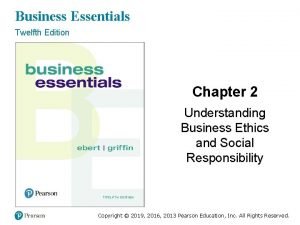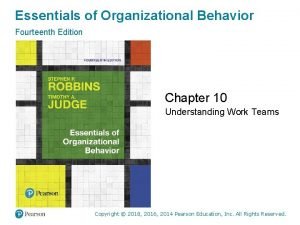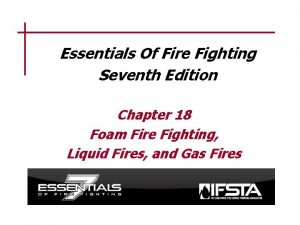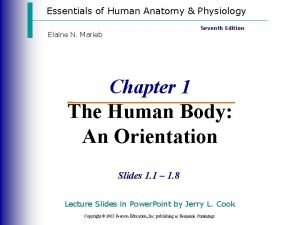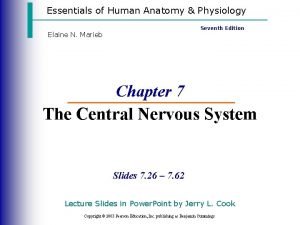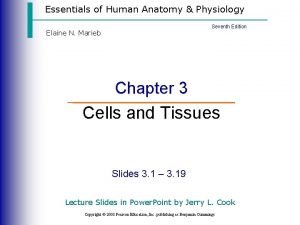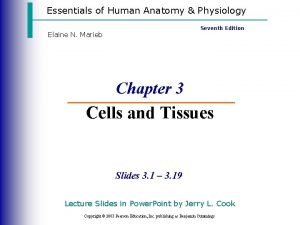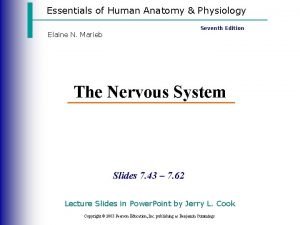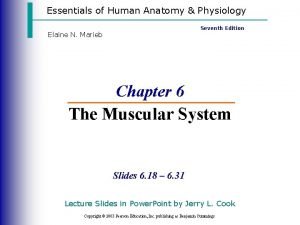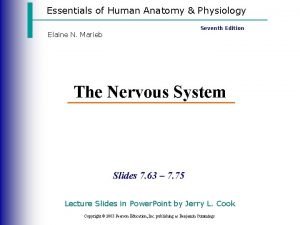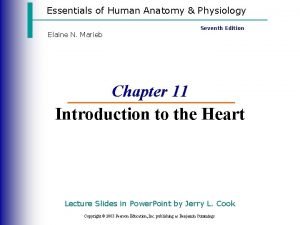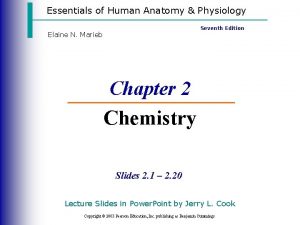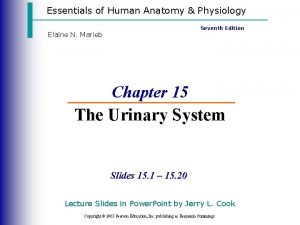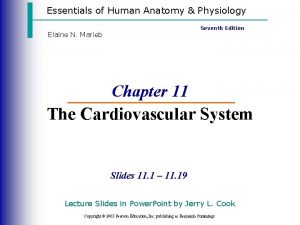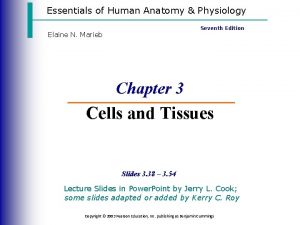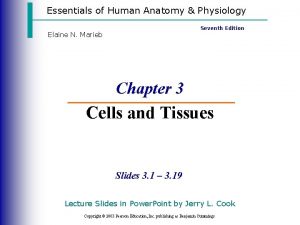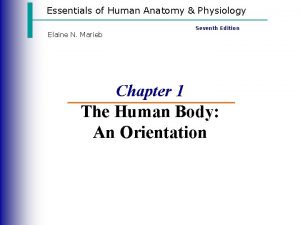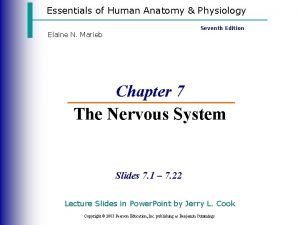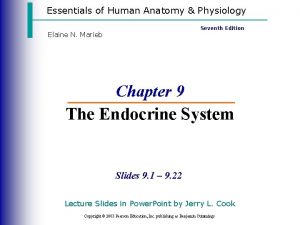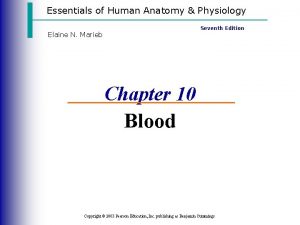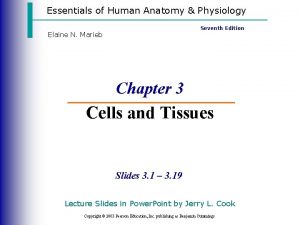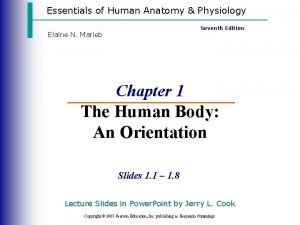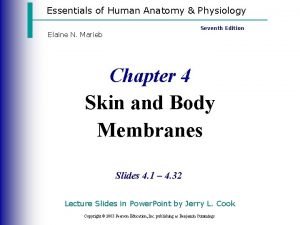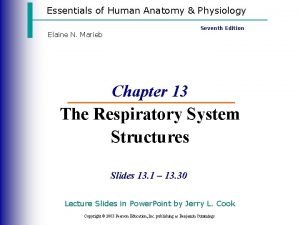Essentials of Human Anatomy Physiology Seventh Edition Elaine




























- Slides: 28

Essentials of Human Anatomy & Physiology Seventh Edition Elaine N. Marieb Chapter 13 The Respiratory System Slides 13. 31 – 13. 49 Copyright © 2003 Pearson Education, Inc. publishing as Benjamin Cummings

Respiratory Sounds · Sounds are monitored with a stethoscope · Bronchial sounds – produced by air rushing through trachea and bronchi · Vesicular breathing sounds – soft sounds of air filling alveoli Copyright © 2003 Pearson Education, Inc. publishing as Benjamin Cummings Slide 13. 31

External Respiration · Oxygen movement into the blood · The alveoli always has more oxygen than the blood · Oxygen moves by diffusion towards the area of lower concentration · Pulmonary capillary blood gains oxygen Copyright © 2003 Pearson Education, Inc. publishing as Benjamin Cummings Slide 13. 32 a

External Respiration · Carbon dioxide movement out of the blood · Blood returning from tissues has higher concentrations of carbon dioxide than air in the alveoli · Pulmonary capillary blood gives up carbon dioxide · Blood leaving the lungs is oxygen-rich and carbon dioxide-poor Copyright © 2003 Pearson Education, Inc. publishing as Benjamin Cummings Slide 13. 32 b

Gas Transport in the Blood · Oxygen transport in the blood · Inside red blood cells attached to hemoglobin (oxyhemoglobin [Hb. O 2]) · A small amount is carried dissolved in the plasma Copyright © 2003 Pearson Education, Inc. publishing as Benjamin Cummings Slide 13. 33 a

Gas Transport in the Blood · Carbon dioxide transport in the blood · Most is transported in the plasma as bicarbonate ion (HCO 3–) · A small amount is carried inside red blood cells on hemoglobin, but at different binding sites than those of oxygen Copyright © 2003 Pearson Education, Inc. publishing as Benjamin Cummings Slide 13. 33 b

Internal Respiration · Exchange of gases between blood and body cells · An opposite reaction to what occurs in the lungs · Carbon dioxide diffuses out of tissue to blood · Oxygen diffuses from blood into tissue Copyright © 2003 Pearson Education, Inc. publishing as Benjamin Cummings Slide 13. 34 a

Internal Respiration Figure 13. 11 Copyright © 2003 Pearson Education, Inc. publishing as Benjamin Cummings Slide 13. 34 b

External Respiration, Gas Transport, and Internal Respiration Summary Figure 13. 10 Copyright © 2003 Pearson Education, Inc. publishing as Benjamin Cummings Slide 13. 35

Neural Regulation of Respiration · Activity of respiratory muscles is transmitted to the brain by the phrenic and intercostal nerves · Neural centers that control rate and depth are located in the medulla · The pons appears to smooth out respiratory rate · Normal respiratory rate (eupnea) is 12– 15 respirations per minute · Hypernia is increased respiratory rate often due to extra oxygen needs Copyright © 2003 Pearson Education, Inc. publishing as Benjamin Cummings Slide 13. 36

Neural Regulation of Respiration Figure 13. 12 Copyright © 2003 Pearson Education, Inc. publishing as Benjamin Cummings Slide 13. 37

Factors Influencing Respiratory Rate and Depth · Physical factors · Increased body temperature · Exercise · Talking · Coughing · Volition (conscious control) · Emotional factors Copyright © 2003 Pearson Education, Inc. publishing as Benjamin Cummings Slide 13. 38

Factors Influencing Respiratory Rate and Depth · Chemical factors · Carbon dioxide levels · Level of carbon dioxide in the blood is the main regulatory chemical for respiration · Increased carbon dioxide increases respiration · Changes in carbon dioxide act directly on the medulla oblongata Copyright © 2003 Pearson Education, Inc. publishing as Benjamin Cummings Slide 13. 39 a

Factors Influencing Respiratory Rate and Depth · Chemical factors (continued) · Oxygen levels · Changes in oxygen concentration in the blood are detected by chemoreceptors in the aorta and carotid artery · Information is sent to the medulla oblongata Copyright © 2003 Pearson Education, Inc. publishing as Benjamin Cummings Slide 13. 39 b


Respiratory Disorders: Chronic Obstructive Pulmonary Disease (COPD) · Exemplified by chronic bronchitis and emphysema · Major causes of death and disability in the United States Copyright © 2003 Pearson Education, Inc. publishing as Benjamin Cummings Slide 13. 40 a

Respiratory Disorders: Chronic Obstructive Pulmonary Disease (COPD) · Features of these diseases · Patients almost always have a history of smoking · Labored breathing (dyspnea) becomes progressively more severe · Coughing and frequent pulmonary infections are common Copyright © 2003 Pearson Education, Inc. publishing as Benjamin Cummings Slide 13. 40 b

Respiratory Disorders: Chronic Obstructive Pulmonary Disease (COPD) · Features of these diseases (continued) · Most victimes retain carbon dioxide, are hypoxic and have respiratory acidosis · Those infected will ultimately develop respiratory failure Copyright © 2003 Pearson Education, Inc. publishing as Benjamin Cummings Slide 13. 40 c

Emphysema · Alveoli enlarge as adjacent chambers break through · Chronic inflammation promotes lung fibrosis · Airways collapse during expiration · Patients use a large amount of energy to exhale · Overinflation of the lungs leads to a permanently expanded barrel chest · Cyanosis appears late in the disease Copyright © 2003 Pearson Education, Inc. publishing as Benjamin Cummings Slide 13. 41

Chronic Bronchitis · Mucosa of the lower respiratory passages becomes severely inflamed · Mucus production increases · Pooled mucus impairs ventilation and gas exchange · Risk of lung infection increases · Pneumonia is common · Hypoxia and cyanosis occur early Copyright © 2003 Pearson Education, Inc. publishing as Benjamin Cummings Slide 13. 42

Chronic Obstructive Pulmonary Disease (COPD) Figure 13. 13 Copyright © 2003 Pearson Education, Inc. publishing as Benjamin Cummings Slide 13. 43

Lung Cancer · Accounts for 1/3 of all cancer deaths in the United States · Increased incidence associated with smoking · Three common types · Squamous cell carcinoma · Adenocarcinoma · Small cell carcinoma Copyright © 2003 Pearson Education, Inc. publishing as Benjamin Cummings Slide 13. 44

Sudden Infant Death syndrome (SIDS) · Apparently healthy infant stops breathing and dies during sleep · Some cases are thought to be a problem of the neural respiratory control center · One third of cases appear to be due to heart rhythm abnormalities Copyright © 2003 Pearson Education, Inc. publishing as Benjamin Cummings Slide 13. 45

Asthma · Chronic inflamed hypersensitive bronchiole passages · Response to irritants with dyspnea, coughing, and wheezing Copyright © 2003 Pearson Education, Inc. publishing as Benjamin Cummings Slide 13. 46

Developmental Aspects of the Respiratory System · Lungs are filled with fluid in the fetus · Lungs are not fully inflated with air until two weeks after birth · Surfactant that lowers alveolar surface tension is not present until late in fetal development and may not be present in premature babies Copyright © 2003 Pearson Education, Inc. publishing as Benjamin Cummings Slide 13. 47 a

Developmental Aspects of the Respiratory System · Important birth defects · Cystic fibrosis – oversecretion of thick mucus clogs the respiratory system · Cleft palate Copyright © 2003 Pearson Education, Inc. publishing as Benjamin Cummings Slide 13. 47 b

Aging Effects · Elasticity of lungs decreases · Vital capacity decreases · Blood oxygen levels decrease · Stimulating effects of carbon dioxide decreases · More risks of respiratory tract infection Copyright © 2003 Pearson Education, Inc. publishing as Benjamin Cummings Slide 13. 48

Respiratory Rate Changes Throughout Life · Newborns – 40 to 80 respirations per minute · Infants – 30 respirations per minute · Age 5 – 25 respirations per minute · Adults – 12 to 18 respirations per minute · Rate often increases somewhat with old age Copyright © 2003 Pearson Education, Inc. publishing as Benjamin Cummings Slide 13. 49
 Endomysium
Endomysium Paratubular cyst
Paratubular cyst Human anatomy & physiology edition 9
Human anatomy & physiology edition 9 Waistline
Waistline Holes essential of human anatomy and physiology
Holes essential of human anatomy and physiology Chapter 1 introduction to anatomy and physiology
Chapter 1 introduction to anatomy and physiology Chapter 2 human reproductive anatomy and physiology
Chapter 2 human reproductive anatomy and physiology Database system concepts seventh edition
Database system concepts seventh edition Information systems literacy
Information systems literacy Molecular biology of the cell seventh edition
Molecular biology of the cell seventh edition Biology seventh edition
Biology seventh edition Human anatomy fifth edition
Human anatomy fifth edition Human anatomy fifth edition
Human anatomy fifth edition Network security essentials 5th edition
Network security essentials 5th edition Business essentials 12th edition
Business essentials 12th edition Essentials of investments 11th edition
Essentials of investments 11th edition Business essentials 12th edition
Business essentials 12th edition Essentials of sociology 5th edition
Essentials of sociology 5th edition Firefighter essentials 7th edition
Firefighter essentials 7th edition Business essentials 12th edition
Business essentials 12th edition The time/space collaboration and social tool matrix
The time/space collaboration and social tool matrix Essentials of organizational behavior 14th edition
Essentials of organizational behavior 14th edition Fire fighting methods
Fire fighting methods Network security essentials 5th edition
Network security essentials 5th edition Criminal justice wedding cake diagram
Criminal justice wedding cake diagram Physiology of sport and exercise 5th edition
Physiology of sport and exercise 5th edition Physiology of lungs
Physiology of lungs Tattoo anatomy and physiology
Tattoo anatomy and physiology Anatomy science olympiad
Anatomy science olympiad









